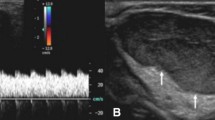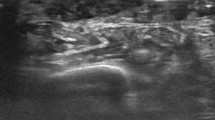Abstract
The purpose of this study was to review the correlation between the imaging studies and the histological findings in the diagnosis of this disease. We retrospectively reviewed 21 lesions in 20 patients (median age, 23.7 years old) who had been diagnosed with cavernous haemangiomas (n=11), capillary (n=6), and mixed (n=3) types. The imaging studies were obtained with plain film radiography (n=20), Tc-99 m bone scans (n=5), angiography (n=7) and magnetic resonance imaging (MRI; n=20). All the patients underwent marginal to wide excision. Based on the imaging studies, the rate of accurate prediction of intramuscular haemangioma using MRI in our study was 90%. Using the preoperative imaging studies and surgical excisions, only one (5%) local recurrence happened 2 years after marginal excision. The remaining patients were free of disease. For the avoidance of recurrence, wide excision is necessary with the help of the imaging studies, which can provide more specific information, making possible the preoperative identification of characteristic features of the tumuor.
Résumé
Le but de cette étude est de montrer la corrélation entre les images radiologiques et les constatations histologiques dans le diagnostic des hémangiomes. Pour cette étude, 21 lésions chez 20 patients (âge moyen 23.7 ans) pour lesquels ont été diagnostiqués un hémangiome caverneux (11), capillaire (6) et mixte (3). Le diagnostic de ces hémangiomes ayant été réalisé par radiographie simple (20), scanner avec technecium (5), angiographie (7) et IRM (20). Tous ces cas ont bénéficié d’une excision large. A partir des images IRM, la prédiction d’hémangiomes intra-musculaires a été de 90%. Seuls 5% des patients présentaient une récidive locale 2 ans après l’excision, les patients restant n’ayant pas présenté de problèmes particuliers. Afin d’éviter la récidive, il est nécessaire de réaliser une excision large à partir du bilan radiographique, scanner, IRM.


Similar content being viewed by others
References
Allen PB, Enzinger FM (1972) Hemangioma of skeletal muscle: an analysis of 89 cases. Cancer 29:8–22
Cohen AJ, Youkey JR, Clagett GP, Huggins M, Nadalo L, D’Avis JC (1983) Intramuscular hemangioma. JAMA 249:2680–2682
Derchi LE, Balconi G, Flaviis L, Oliva A, Rosso F(1989) Sonographic appearances of hemangiomas of skeletal muscle. J Ultrasound Med 8:263
Enzinger FM, Weiss SW (1988) Benign tumors and tumorlike lesions of blood vessels. In: Soft tissue tumor, 2nd edn. Mosby, St. Louis, p 512
Fergusson IL (1972) Haemangioma of skeletal muscle. Br J Surg 59:634–637
Greenspan A, McGahan JP, Vogelsang P, Szabo RM (1992) Imaging strategies in the evaluation of soft-tissue hemangiomas of extremities: correlation of findings of plain radiography, angiography, CT, MRI and ultrasonography in 12 histologically proved cases. Skeletal Radiol 21:11–18
Ly JQ, Sanders TG, Mulloy JP, Soares GM, Beall DP, Parsons TW, Slabaugh MA (2003) Osseous change adjacent to soft-tissue hemangiomas of the extremities: correlation with lesion size and proximity to bone. AJR 180:1695–1700
Murata YJ, Yamada I, Umehara I, Shibuya HTS (1997) The use of three-phase scintigraphy for diagnosing hemangiomas of the extremities. Clin Nucl Med 22(6):372–375
Shallow TA, Eger SA, Wangner FB (1944) Primary hemangiomatous tumors of skeletal muscle. Ann Surg 119:700–704
Scott, JES (1957) Hemangioma in skeletal muscle. Br J Surg 44:496–501
Sue JS, Hwang G, Hahn SB(1994) Soft tissue hemangiomas: MR manifestations in 23 patients. Skeletal Radiol 23:621–625
Trout HH, McAllister HA, Giordano JM, Rich NM (1985) Vascular malformations Surgery 97:36–41
Watson WL, Mc Carthy WD (1940) Blood and lymph vessel tumor. A report of 1,056 cases. Surg Gynecol Obstet 71:569–588
Welsch D, Hengerer AS (1980) The diagnosis and treatment of intramuscular hemangiomas of the masseter muscle. Am J Otolaryngol 1:186
Yuh WTC, Kathol MH, Sein MA, Ehara S, XHiu L (1987) Hemangiomas of skeletal muscle: MR findings in five patients. AJR 149:765–768
Author information
Authors and Affiliations
Corresponding author
Rights and permissions
About this article
Cite this article
Wu, JL., Wu, CC., Wang, SJ. et al. Imaging strategies in intramuscular haemangiomas: an analysis of 20 cases. International Orthopaedics (SICO 31, 569–575 (2007). https://doi.org/10.1007/s00264-006-0229-1
Received:
Accepted:
Published:
Issue Date:
DOI: https://doi.org/10.1007/s00264-006-0229-1




